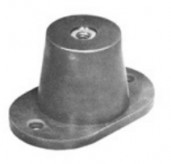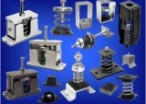NOISE AND VIBRATION CONTROL

VIBRATION ISOLATORS
RD Shim - Elastomeric
Molded neoprene isolator.
Load plate fused to the isolator.
Threaded cast iron mounting hole in the isolator.
Load capacities of up to 1814 kg (4000 lb).
Static deflection of up to 13 mm (½ ").
Oil and corrosion resistant.
Description:
The RD model isolator is a molded piece of neoprene encapsulated with metal inserts. Are color coded to identify their capacity. Each isolator has 2 (two) holes in the bottom loading surface and a threaded hole in the upper surface for attaching the supported equipment. The neoprene is highly resistant to oil. The RD isolator is designed to meet the specified loads with maximum isolation and longest possible service life using neoprene compounds. It is designed to more than 13 mm (0.5 ") deflection available in four (4) sizes and eleven (11) carrying capacities from 25 to 1814 kg (55 to 4,000 lbs).
Applications:
The RD model neoprene isolators can be used to isolate noise and high frequency vibrations generated by mechanical equipment located on structurally supported level or on a pier or platform. Typical applications are limited to isolation of mechanical equipments with minimal rotation speed of 1750 rpm, when located on a raised platform, and also small hydraulic pump coupled to a low power motor, small fans, small low pressure air conditioners and similar equipments. Usually they are selected only when the initial cost must be minimized.
Specifications:
• Noise isolation includes use in floating floors, as high efficiency "pad" interrupting the transmission of noise from suspended "hangers" and as supports for mechanical equipments seated on the ground.
• Neoprene molded.
• Oil resistant.
• Cast steel load plate on the top surface.
• Insert with threaded hole for attachment of the supported equipment.
• Steel load plate on the lower surface fused to the isolator.
• Two holes for mounting and bottom anchoring.
• The top and bottom surfaces have anti-sliding raising.


 Portuguese
Portuguese